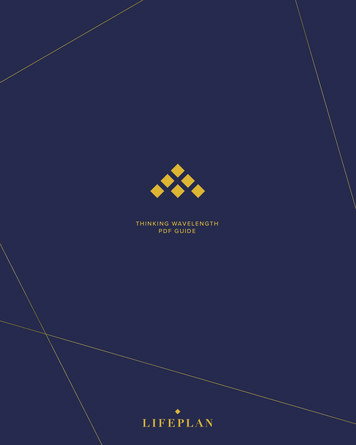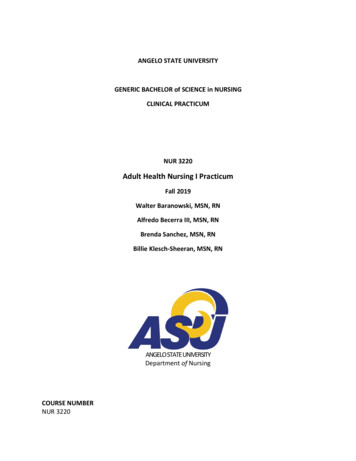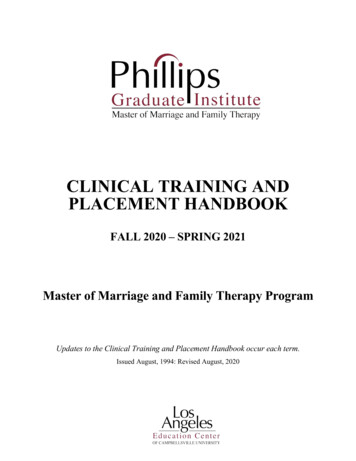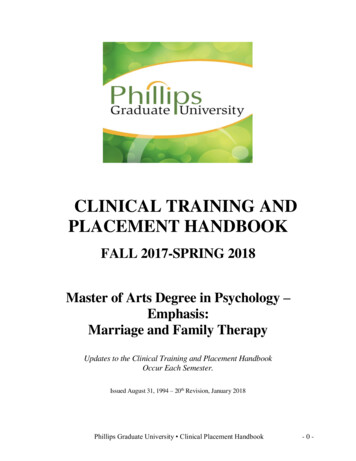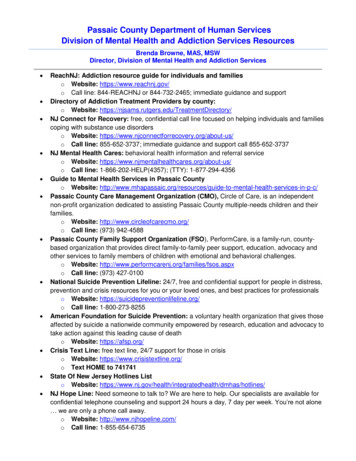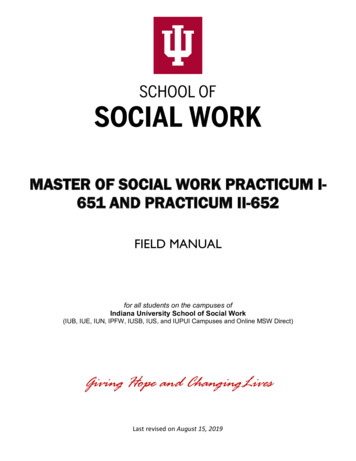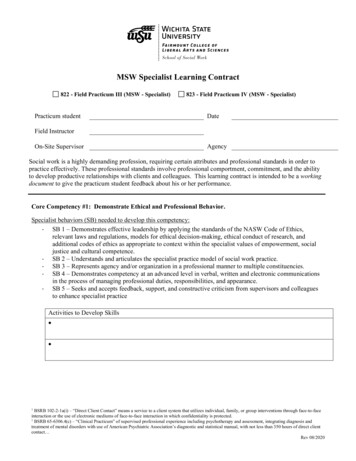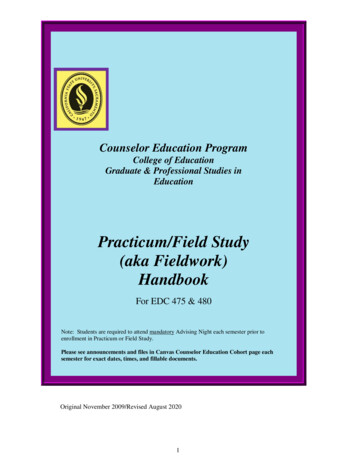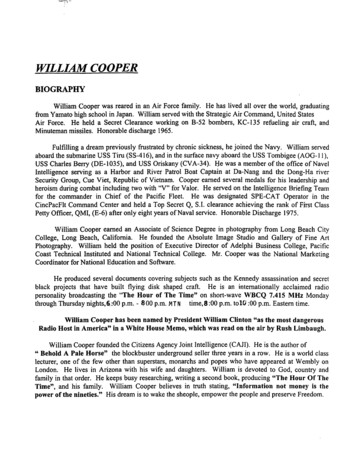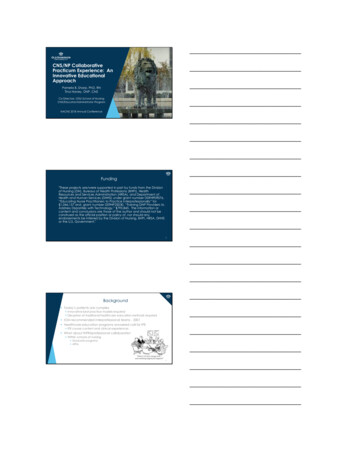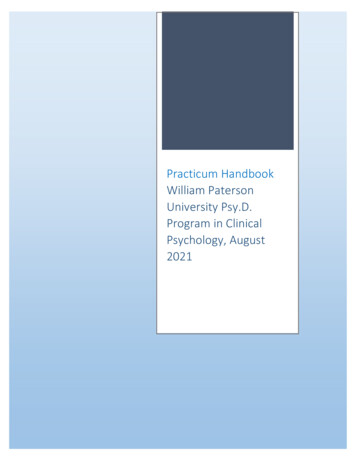
Transcription
Practicum HandbookWilliam PatersonUniversity Psy.D.Program in ClinicalPsychology, August2021
1ContentsIntroduction . 2Glossary of Terms . 3General Introduction to Practicum and Internship . 6Clinical Training at WPU: A Generalist Model . 8FAQs About Practica . 92021-2022 Externship Guidelines from NYNJADOT . 20Guidelines on Supervision and Calculating Practicum Hours . 20Time2track Instructions. 21Case Reports . 22Sample Psychology Interview Questions . 25Psy.D. Program Schedule by Year . 30Summary of Internship Application Process and Associated Costs . 32Appendix: Sample Practicum Communications . 41stSample Letter of Readiness-1 Year . 41Sample Letter of Readiness-2nd Year and Beyond . 42stSample Cover Letter-1 Year . 43Sample Cover Letter-2nd Year . 45stSample CV-1 Year . 47Sample CV-2ndYear . 49Instructions for Submitting Externship Applications Through the PsychPracticum Portal . 58Sample Communication About Missing Class for a Practicum Interview . 61Appendix: Cheatsheet for Completing Additional Practica and for When Practica Extend Into Summer . 62
Introduction2Dear William Paterson Psy.D. Students,Practicum is one of the most rewarding and exciting parts of your doctoral studies. To have asuccessful practicum experience, you need to be aware of the numerous guidelines and processesfor applying, interviewing, and eventually completing supervised clinical training at your chosenpracticum site. You should also know about how the skills you build on practicum shape youreventual doctoral internship opportunities and beyond. This handbook will serve as a guide tothis process, and should be used in close collaboration with faculty and mentors in the Psy.D.program. The handbook is divided into two sections. The main section includes basicinformation and guidelines about the practicum and internship application process and your roleas an extern. The appendix section includes a collection of sample resources to help you withyour applications. There are different sample documents for both first and second years, takinginto account the increased clinical experiences that second years will have from their firstpracticum.Keep in mind that this handbook does not replace close collaboration with a faculty member inthe Psy.D. program. The best thing you can do for your practicum and internship applicationsand experience is to work with one or more of the Psy.D. faculty in order to ensure that you havethe greatest chance of success.Good Luck!Best,Ari Lakritz, MAPsy.D. Graduate Student, Class of 2020For 2021-2022, the Program Directors and Director of Clinical Training at WPU are:Co-Program Directors: Jan Mohlman, PhD, Co-Program Director (PD), WPU PsyD program, mohlmanj@wpunj.edu Megan Chesin, PhD, Co-Program Director (PD), WPU PsyD program,chesinm@wpunj.edu Aileen Torres, PhD, Director of Clinical Training (DCT), WPU PsyD program,torresa72@wpunj.edu
Glossary of Terms3These terms appear in the Student Handbook or other communications you likely come acrossthrough your training experiences. They are organized by the level of training, with the finallevel (licensing) listed first.(1) LicensingASPPB – Association for State and Provincial Psychology Boards. The alliance of state,provincial, and territorial agencies responsible for the licensure and certification of psychologiststhroughout the United States and Canada. In other words, this is the oversight body for all statelicensing boards. They design, oversee, and implement the EPPP and set policy that tricklesdown to state licensing boards for the practice of psychology. http://www.asppb.net/EPPP –Examination for Professional Practice of Psychology is a licensing examinationdeveloped by the Association of State and Provincial Psychology Boards (ASPPB) that is used inmost U.S. states and Canadian provinces. This is the national exam taken after completion of thedoctoral degree and usually required for licensure. There has been discussion that the EPPP willbe administered in two parts, and test fee is about 600 for each part (total cost about 1200).(2) Internship and Postdoctoral trainingAPPIC – Association of Psychology and Postdoctoral Internship Centers. This is theorganization that compiles internship and postdoctoral training information. Your applicantportal and hours tracking software (integrated with time2track) are hostedhere. https://www.appic.org/AAPI –APPIC Application for Internship. Hosted within the APPIC site on a portal, the portalusually opens for students in July and is where you enter, edit and ultimately submit yourinternship application materials. https://www.appic.org/Internships/AAPINMS-National Matching Service. This is the computerized service used to match prospectiveinterns with sites based on the student’s and site’s rank order. Priority is given to student’sranked list, not the site’s ranked list. https://natmatch.com/psychint/index.html(3) Externship/Practica
4NYNJADOT – New York New Jersey Association of Directors of Training. This organizationconsists of Directors of Clinical Training (DCT) in NY and NJ who have developed guidelines togovern the process of applying to externships and accepting externship offers in the NY and NJregion.(4) Professional Association and AccreditationAPA – American Psychological Association. http://www.apa.org/PWC – Professional wide competencies. These are the domains of practice (see APA websiteand WPU Student Handbook for elaboration) defined by APA Standards of Accreditation (SoA).Minimum levels of achievement in these are required to receive your degree and ultimatelypractice psychology.The nine PWC:1. Research2. Ethical and Legal Standards3. Individual and Cultural Diversity4. Professional Values, Attitudes, and Behaviors5. Communication and Interpersonal Skills6. Assessment7. Intervention8. Supervision9. Consultation and Interprofessional/Interdisciplinary skillsDSK – Discipline Specific Knowledge. These are the domains of knowledge (see WPU StudentHandbook for elaboration) defined by APA Standards of Accreditation (SoA). Minimum levelsof achievement in these are required to receive your degree and ultimately practice psychology.The ten DSK:1. Affective Aspects of Behavior2. Biological Aspects of Behavior3. Cognitive Aspects of Behavior4. Developmental Aspects of Behavior5. Social Aspects of Behavior6. Advanced Integrative Knowledge of Basic Discipline-Specific Content Areas7. History and Systems of Psychology8. Research Methods9. Statistical Analysis10. Psychometrics
SoA – Standards of Accreditation. These are the areas of knowledge and skills programs mustcover to meet professional practice standards to become accredited.5CoA - Commission on Accreditation. This is the group of psychologists who judge and reviewprograms seeking accreditation.
General Introduction to Practicum and Internship6General Information: Practicum (also sometimes called ‘Externship’) is the name for the partof your graduate training in years 2, 3, and 4, at sites in the community at sites external to WPU.years 2, 3, and 4. The primary purpose of practicum is to gain clinical experience. Over thecourse of the Psy.D. program, students are expected to complete a minimum of 1,8001 semesterhours of practica that are supervised by a doctoral-level licensed clinical psychologist. Allstudents must enroll in the corresponding Practicum courses (I – VI) to supplement externalpracticum training. These advanced clinical experiences begin in the fall of the second year andcontinue until the end of the fourth year. Students may also complete practica in the fifth year(and beyond) if they do not apply or match for the doctoral internship. Practica are designed toassist students in achieving competence as future psychologists in the practice of psychology andto provide preparation for the required doctoral clinical internship. The emphasis is on thequality of clinical experience and supervision, though a minimum of 400 intervention hours and100 assessment hours are required in order to be eligible to apply for internship in the fourthyear, as are completion of 5 integrated psychological reports. To set you up to meet thisrequirement, by end of year 3 (meaning June 30 of your third year), you must in your 2ndpracticum complete a practicum focused on or at least with a major rotation/component inassessment, even if you are dedicated to treatment, and vice versa if you are dedicated toassessment by the end of year 3. By the end of year 3, you must also have administered at least 2personality measures, intellectual tests, cognitive tests, and/or neuropsychological tests.Practicum GuidelinesHours: For 2021-2022, maximum hours by program year for practicum are as follows: Years 2and 3: No more than 16 hours per week. Year 4 : No more than 20 hours per week. It isrecommended that students spend a minimum of 6002 hours in practicum during a 10- to 12month period, with 300 hours in service-related activities, defined as treatment/intervention,assessment, interviews, report-writing, case presentations, and consultations. One-hundred fiftyof these hours must be in face-to-face client contact. In addition, students must receivesupervision for 25% or more of their service-related hours. Seventy-five percent of thissupervision must be individual supervision by a licensed psychologist. For example, if a studentcompletes 150 service-related hours in one semester, then that student would also receive 38hours of supervision that semester. Students also receive weekly secondary supervision throughactive participation in the faculty-directed Practicum course, and students may count up to 3hours per week in support activities from this course toward hour totals on the AAPI.Observation: Each student must be directly observed by his or her primary practicum supervisorat least once per semester. To meet this observation requirement, students may have theirsessions videotaped or audiotaped; may be viewed through a one-way mirror during a livesession by their supervisor; or may have their supervisor sit in on a session. The directobservation should be reviewed in an individual supervision meeting within three weeks of theobservation.Time Period: Practicum hours for each year must be completed within a period not to exceed 12consecutive months. Students may start at their practicum as early as July 1 the summer beforetheir practicum course begins (assuming that this is desired by the student and practicum site).Students who begin practicum in the summer must notify the PD of June 1. They must also1 Forthose who were on externship during the COVID-19 global pandemic, this total is reduced to 1680 hours.
2 Dueto the COVID-19 global pandemic, this was reduced to 480 hours for the AY 2019-2020.7participate in secondary supervision with the PD until the corresponding Practicum course beginsin the fall semester. If students extend their practicum training beyond the last day of the springterm, they will receive an incomplete in the associated practicum course (Practicum II, IV, orVI). After the practicum training in the associated practicum course has been completed and allpaperwork for the practicum experience has been submitted, the incomplete will be converted toa grade. No additional malpractice insurance is required for early start or extending practicumpast the end of spring semester. Hours accrued after the end of the spring semester can becounted toward the hour totals on the AAPI. (Please see the Cheat sheet for Practica that Extendinto the Summer at the end of this handbook.)Approval by DCT: Students must have the approval of the DCT prior to applying to andaccepting a placement each year. All students are required to carefully follow the applicationguidelines established by the NYNJADOT. The guidelines can be found on the homepage of theindex of externship opportunities, which is now sponsored by the American PsychologicalAssociation (APA): https://psychpracticum.apa.org/Please be aware that these guidelines are intermittently modified, and when this occurs the newinformation will be distributed to you by the DCT. However it is your responsibility to befamiliar with the current set of guidelines for each application cycle. An update is expected eachSpring or Summer.Second-Year Project: As documented in the WPU PsyD Student Handbook, Psy.D. students arerequired to submit a second-year project, which is either: 1) a written clinical caseconceptualization; or 2) a clinically-relevant empirical research project. If you choose a writtenclinical case conceptualization, your practicum will serve as the place for you to identify a clientwho will be the basis of your case conceptualization. If you choose this route, you should ideallystart identifying possible clients to use for your case conceptualization as early as possible onyour practicum. Any notes you take on your sessions with the client, as well as worksheets orassessments you administer will be essential for creating a quality case conceptualization aboutyour client. We encourage you to administer at least one standardized assessment, such as theBrief Symptom Inventory, several times across your intervention. This means you should haveyour eventual second-year project in mind when you begin working with your first clients. Youwill need to obtain permission from your practicum supervisor if would like to administerassessments and/or you intend to use a practicum case as the subject of this project.APPIC: APPIC stands for the Association of Psychology Postdoctoral and Internship Centers.This is the governing body which oversees a majority of the psychology internship andpostdoctoral positions in the US and Canada. When you apply to internships, you will useAPPIC’s application, the AAPI and the NMS, national matching service, to procure an internshipplacement. This means that it is very important for you to read the APPIC applicationinformation carefully before you start externship to see what type of practicum activities you willbe expected to have participated in when you eventually apply for your internship. APPIC doesnot currently accredit or supervise externship sites.Doctoral Internship: Typically students will prepare an application for the doctoral internshipusing the AAPI through APPIC during the summer and fall of the 4th year (see below). In orderto apply for internship, students must obtain a letter of readiness from the Director of Clinical
8Training and Graduate Program Director. To qualify for this letter, students must have passed theComprehensive Exam, Dissertation I, and Dissertation Proposal before September 1st of their 4thyear.Clinical Training at WPU: A Generalist ModelAt WPU, our curriculum is designed to train a generalist psychologist. Accordingly, we valueand provide broad and general preparation for the independent practice of health servicespsychology at the entry level, and do not have concentrations or tracks in specific areas.However, we also know that some students enter the program with the intention of specializingin the highly competitive fields of Child/Adolescent Psychology or Neuropsychology. Thesetypes of specialization require specific didactic training and supplemental clinical experiences.Didactic training typically requires additional coursework, which is not available in the existingcurriculum at WPU. Supplemental clinical experiences will commonly require you to spend anextra year in training. Examples of suggested activities to specialize in Neuropsychology orChild/Adolescent Psychology follow. This is not an exhaustive list nor does it guarantee you willbe competitive in these highly competitive fields. Students interested in specializing areencouraged to acculturate into these worlds by joining organizations and professionalassociations dedicated to promoting basic and applied knowledge in these areas and to findmentors inside and outside of the WPU Program to guide them in their professionaldevelopment.Suggested Training Elements for a Student Interested inNeuropsychology1. One clinical practicum that includes at least some therapy training beyond cognitiverehabilitation for the accrual of intervention hours2. At least 2 year-long neuropsychology-focused practica, preferably with board-certifiedneuropsychologists3. Participation in brain sciences research (basic or applied) or neuropsychologicalassessment research, culminating in a dissertation project that has aneuropsychology dimension or focus4. Completion of a functional neuroanatomy course, such as that provided on-line by theNational Academy of Neuropsychology, Inc.5. The hour requirements for internship readiness are different than the hours required fornon-neuropsychology-focused doctoral internships. The focus should be on accrual ofassessment experiences as detailed above.Suggested Training Elements for a Student Interested inChild/Adolescent PsychologyAt least 2 clinical practica focused on serving youth that provide for the following:1. Individual therapy with children
92. Clinical experience with preschool-aged children, elementary-school agedchildren or adolescents depending on sub-specialty of interest3. Treatment sessions with families or parents in a hospital, community mentalhealth or school setting4. Completion of assessments:1. 5 WISC’s or WPPSI’s (Kaufman or Woodcock-Johnson CognitiveAssessments may be substituted)2. One adaptive measure (ABAS-3, Vineland-3)3. 3 Personality Assessment (i.e. Rorschach, MMPI-A, PAI-A)4. One integrated psychological report based on a child/adolescent (0 – 17years) that also includes general and/or specific symptom measures (i.e.,BASC-3, CBCL, YSR, RCMAS, CDI-2)FAQs About PracticaGeneral Information1. What is the difference between an externship and a practicum?Nothing – these terms are interchangeable. Practica is the plural of practicum.2. What is NYNJADOT?This is the regional association of NY and NJ Association of Directors of Training(NYNJADOT) involved with overseeing clinical training of graduate students. It typicallyincludes Directors of Clinical Training from clinical psychology doctoral programs.NYNJADOT meets twice annually to review policy and procedures, and improve students’training experiences in NY and NJ. Members of NYNJADOT also meet twice annually withpracticum and internship site directors in NY and NJ to further monitor training of psychologydoctoral students.3. What is the PsychPracticum Portal?The PsychPracticum Portal (Portal) is a web-based site, which is hosted by APA. You will find alisting of all NYC metro practicum sites on the portal, including a description of the site,activities and hours for externs, and other details relevant to application. Additionally, guidelinesfor students and programs participating in the externship match are housed there. Sites (ideally)update their information from year to year by November 1. If a site has not updated theirinformation by this date, use the prior year’s information as a guide. The Portal is available here:https://psychpracticum.apa.org/. The Portal will be your main resource to apply to practicumsites. Each practicum site on the Portal maintains a page where they list contact info, credentialsand materials required for applications. Application materials are also uploaded by studentapplicants through the Portal starting in January, typically on the day after MLK day.
104. What materials do I need to send in with my application?Different sites require different materials, but all sites will require the following items: Cover letterCurriculum vitae (MUST INCLUDE DCT EMAIL torresa72@wpunj.edu )Letters of recommendation: usually between two and three.Letter of readiness from the Director of Clinical Training (DCT for 2021-2022 is Dr.Aileen Torres).Most sites will also require one or both of the following items: Sample case conceptualization/intakeSample testing reportSites may also ask for additional materials, such as: Graduate transcript (usually unofficial)Autobiographical statementYou will receive support for materials development in the Introduction to Clinical Practicecourse and from your program mentor. Your materials must be in final polished form beforesubmission to the DCT. Ensure your materials are proofread thoroughly. Details matter! Enlistyour peers and external supports to review your application materials prior to approaching yourmentor. Career service at WPU is also a good resource: https://wpunj.edu/careercenter/index.html.The letter of readiness will be provided for you by mid-January by the DCT (see the sample atthe end of this handbook). You will be responsible for everything else, including procuringletters of recommendation from professors or supervisors. It is good practice to giveindividuals writing your letters of recommendation at least two weeks’ notice. Once youhave completed your first practicum, we advise you to obtain one letter of recommendation froma practicum supervisor and one letter of recommendation from program faculty, typically yourmentor.If you are a first year student, please keep in mind that you may not yet have a testing report orcase conceptualization about a real client. We advise that you do not apply to practicum sites inyour first year requiring these items.5. I am seeing that many sites on the Portal state they will only take 3rd years and beyond.If I am a first year, should I still apply?If a site specifies more advanced students, they are probably looking for specific assessment orintervention experiences that are uncommon for first years. In addition, with a limited number ofsites to apply to, it most likely does not make sense to expend an application to a site with a lowlikelihood of acceptance. Rather, it would be better to identify sites in your first year that mayprepare you for this advanced opportunity.
116. What types of sites should I prioritize as a first year applicant to externship?It is important to be realistic when you apply to practicum for the first time. As a first year, youmay have to settle with a practicum site that is not exactly the kind of site you would prefer. Thesite may be a longer commute than you would like, or the setting of the site may be one that younever envisioned for yourself, or the client population may not be your most preferred. The moreadvanced, larger, or well-known sites on the Portal, such as large medical facilities or researchcenters, may be a better choice for you as a 2nd or 3rd year student going into your 2nd or 3rdpracticum. Keep this in mind when you apply, and do not become discouraged if you get a lessthan-perfect practicum site your first year. Also, when reviewing sites on the Portal, notewhether the site will even consider students going into their 1st year of practicum. If a sitereports that they require prior practicum experience, note this and realize the site may be a realreach as a 1st practicum training site. The most important thing is that your site adheres to theNYNJADOT (and therefore the ASPPB) guidelines for psychology externship training.You should also aim to have at least 2 sites that overlap with something you have donepreviously, so that the site can easily see a good fit. Even if you do not have clinical experience,you may have other research or volunteer experiences that relate in a meaningful way to certainsites.You are also advised to apply to at least one or two sites where WPU students have previouslycompleted practicum.Note: As described on the Portal, there is a second wave of applications that takes place a fewweeks after the first date on which applications may be submitted. If you do not have aninterview by the time the second wave of applications are due, contact the DCT for guidance, asit may be in your best interests (and you are allowed) to apply to additional sites.7. How do I apply to a site?Your site will provide info on the PsychPracticum Portal. Most sites prefer to receiveapplications via upload on the portal, but there may be exceptions. Some sites, for instance,prefer the letters of recommendation be sent through email by the recommender. Make sure youare familiar with the policies of the sites where you choose to apply so that you do not have toscramble at the last minute.In terms of the format of the application, you should upload all of your application materials inONE pdf, unless the site requests otherwise. Instructions on how to combine several documentfiles into a single pdf can easily be found online.8. What is the difference between sites not listed on the Portal and those that are listed?Sites on the Portal must adhere to the NYNJADOT application guidelines, including dates andtimes when applications can be accepted or practicum offers can be made. Sites that are not
listed are not required to follow the NYNJADOT guidelines, and may set their own policy andprocedures in these areas.129. Should I prioritize applying for a site listed on the Portal compared to sites not listed?This question is largely dependent on your own specific needs and goals, and our ability to locatehigh quality training sites on our own without using the Portal. In addition to sites listed on thePortal, students have also obtained valuable training at externships that are not listed on thePortal.10. Will I be disadvantaged in future years if I do not apply for a site listed on the Portal?No, however please note the discussion under question 9 above.11. Is there such a thing as an APA or APPIC accredited practicum?No, there is no governing body that approves or accredits external practica (see introduction formore on APPIC). However, we do attempt to model our program’s practicum requirements(things like the ratio of hours of supervision to hours of direct client care, etc.) to follow bestpractices for psychology training. These best practices are based off the suggestions for predoctoral psychology training by NYNJADOT (see question 2 above), as well as the Guidelinesfor training summarized by the Association of State and Provincial Psychology Boards (ASPPB).The ASPPB is an organized group of state licensure bodies, and their suggestions for psychologytraining directly reflect the type of training and hours required to be eligible for psychologylicensure.12. Can I reject a practicum site in the hopes I will receive something better after the matchhas started or in the clearinghouse?We strongly advise students not to reject all offers and choose to enter clearinghouse in hopes ofsomething better. Most practicum slots are taken by the end of the first day of the match. Theonly exception to rejecting all offers and entering the clearinghouse is if your mentor or amember of the core faculty has agreed to work with you directly to help you secure anotherplacement. If a student would like to work with a member of the core faculty to secure aplacement in the clearinghouse, the student must submit, in writing, the faculty who has agreedto assist, signed by both student and faculty.13. How many interview offers should I anticipate?Sites vary considerably in how they approach the interview process. While your chances ofmatch increase as the number of interview offers increase, if you receive a few interview offers,you also have a strong chance of matching on the first day practicum offers are released. Youwill also have a chance to apply to more sites later in the process if you have received 3 or fewer
13interview offers. Please also be advised that as you become more focused in your interests, youmay receive only a few interview offers, but these sites may be very interested in you. Though itis difficult, please try to avoid comparing your “stats” to your peers. In the history of theprogram, every student has matc
Handbook for elaboration) defined by APA Standards of Accreditation (SoA). Minimum levels of achievement in these are required to receive your degree and ultimately practice psychology. The ten DSK: 1. Affective Aspects of Behavior 2. Biological Aspects of Behavior 3. Cognitive Aspects of Behavior

